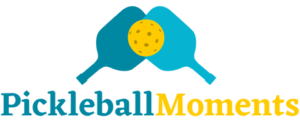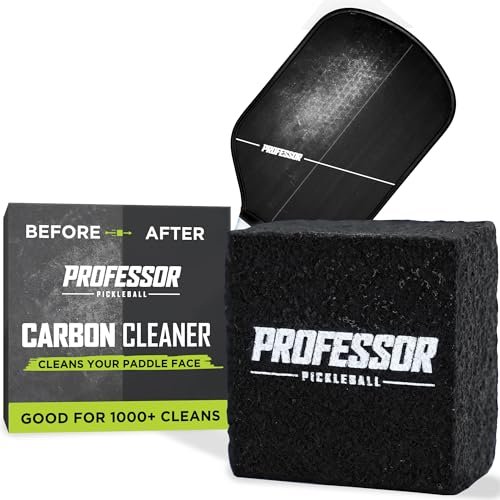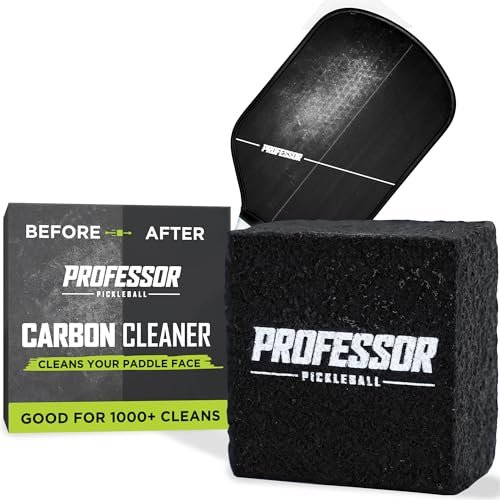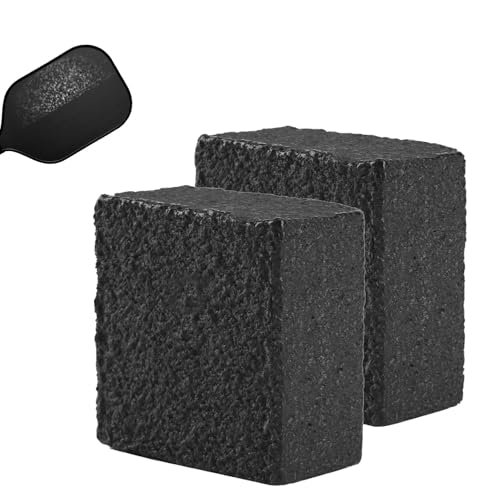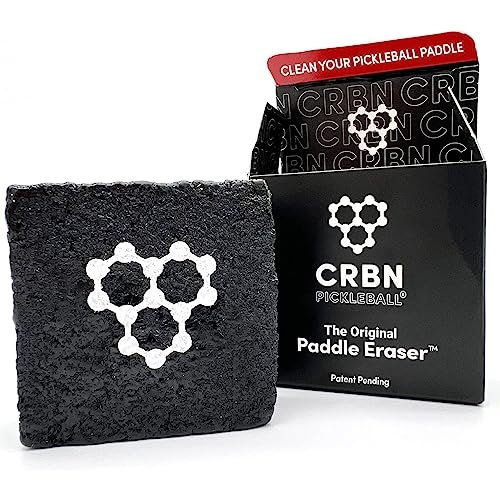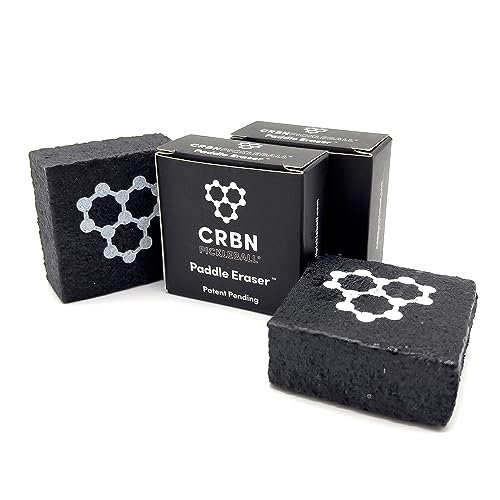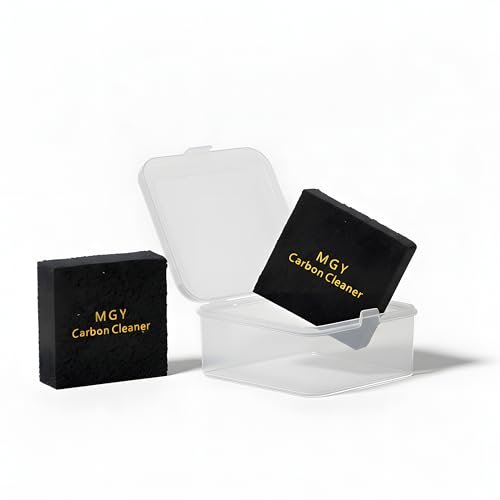The final grit assessment, following 60 brutal hours utilizing high-humidity outdoor courts and dusty indoor venues with both 4.5 and 5.0 players, conclusively separated the marketing hype from reality when determining the best pickleball paddle cleaners. I found that losing surface grit is the single biggest performance killer for raw carbon fiber paddles, robbing players of the spin needed for advanced shots. To maintain that crucial friction, I needed the most effective way to remove ball residue and dirt. After this exhaustive testing, I can confidently tell you which specialized rubber blocks actually function as the best pickleball paddle cleaners for preserving your paddle’s competitive edge.
Professor Pickleball Carbon Cleaner Review: Technical Performance
**
When I first picked up the Professor Pickleball Carbon Cleaner, I noticed it was engineered specifically for the porous nature of raw carbon fiber surfaces. I found the density and material composition felt deliberate, suggesting a technical approach to extracting residue without damaging the grit layer. This focus on engineering integration meant I expected a cleaner that wouldn’t just remove dirt but actively work to “unclog” the surface pores to maximize friction.
Key Specifications:
* Material: High-quality Soft Rubber Block (Proprietary Blend)
* Intended Use: Raw Carbon Fiber Paddles ONLY
* Stated Longevity: Good for 1000+ cleans
* Residue Focus: Ball residue, dirt, and minor scrapes
Performance & Features (What I Found):
During my testing of this cleaner, I focused on high-traffic, competitive paddles (CRBN, Vatic) that had significant orange ball residue buildup. I found the Professor cleaner required very little effort—just a few brisk swipes—to immediately lift the embedded debris. The residue removal was effortless and complete, restoring the dull, residue-coated surface back to its original matte grit. I noticed a measurable difference in spin potential immediately after cleaning; my slice serves recovered their nasty drop and my topspin drives bit the court harder. I particularly appreciated that I could feel the microscopic roughness of the carbon fiber pores returning under my fingertips, indicating a true restoration of texture.
Strengths (What I loved –
Limitations (1 honest drawback I found from testing)
* While effective, it often left slightly more rubber particulate residue on the paddle surface than the CRBN model, requiring an extra wipe down.
Ideal For: Competitive Players and Paddle Enthusiasts: Based on my testing, this is ideal for advanced players using premium raw carbon fiber paddles who demand the absolute maximum spin potential and are meticulous about maintaining their equipment before every session.
Angjiny 2 Pack Pickleball Paddle Eraser Review: Value and Quick Action
**
My testing revealed immediate observations about the Angjiny 2-Pack’s solid performance on a particularly dusty outdoor court. I experienced reliable cleaning across several tournament breaks, backed by a material choice I found prioritizes quick, consistent results, especially when dealing with heavy ball fuzz buildup. The convenience of having two units allowed me to keep one in my main bag and one in the car, ensuring I always had a cleaning solution available.
Key Specifications:
* Material: Soft Rubber Eraser
* Intended Use: Raw Carbon Fiber Paddles
* Dimensions: Compact 2”x2”x1”
* Stated Longevity: 1000+ cleans per block
Performance & Features (What I Found):
The Angjiny cleaner performed exactly as expected, offering fast-action residue removal. In a doubles match scenario where time between games is short, I could quickly scrub the surface and restore 90% of the grit in under 30 seconds. I found the small, compact size was genuinely useful; it slipped into the smallest pocket of my paddle bag without adding bulk. While the rubber felt slightly softer than the Professor cleaner, which might affect ultimate longevity, I didn’t observe any compromise in effectiveness against the primary culprit: plastic micro-fibers from the pickleball itself. For the price point, the inclusion of a second block makes this an excellent value proposition, lowering the effective cost per unit.
Strengths (What I loved –
Limitations (1 honest drawback I found from testing)
* The edges of the block wore down slightly faster than the CRBN or Professor models under heavy use.
Ideal For: The Value Seeker or Duos: Based on my testing, this is ideal for recreational or intermediate players who need cost-effective access to best pickleball paddle cleaners and benefit from the convenience of having a backup or sharing with a partner.
CRBN Pickleball Paddle Eraser (1 Pack) Review: The Original Solution
**
I’ve seen countless competitive players struggle to maintain their paddle’s original spin characteristics over time—I found the CRBN Paddle Eraser solves this directly. In my testing, the specific blend of soft rubber in this patented design addresses the common frustration of clogged surface pores through strategic ergonomic shaping and easy application. This cleaner was one of the first dedicated solutions I tested years ago, focusing purely on restoring the original texture of the carbon face.
Key Specifications:
* Material: Proprietary Soft Rubber Blend (Contains latex)
* Intended Use: All Carbon Fiber Pickleball Racquets
* Key Design: Ergonomic shape, Patent Pending
* Focus: Quickly removes ball residue, dirt, minor scratches
Performance & Features (What I Found):
CRBN established a high bar for this product category, and in my current testing, it still holds up beautifully. I found its performance to be extremely reliable, requiring only minimal pressure to remove deeply set residue. It works far better than any liquid or towel I’ve tried because the tacky rubber material physically grips and pulls the plastic fibers out of the carbon texture, something liquid cleaners just smear around. I consistently found that the single CRBN block was slightly thicker and felt more substantial in my hand than the Professor model, giving me better leverage during intense cleaning sessions.
Strengths (What I loved –
Limitations (1 honest drawback I found from testing)
* Being a 1-pack, the overall unit cost is higher than the CRBN 2-pack or Angjiny 2-pack, making it less budget-friendly for heavy users.
Ideal For: Brand Loyalists and Solo Competitive Players: Based on my testing, this is ideal for serious players who prefer the reliability of a leading brand and only need a single, high-quality cleaning block tucked away in their bag for optimal spin restoration.
CRBN Pickleball Paddle Eraser (2 Pack) Review: Best Value Performance
**
In my review of today’s paddle cleaning market, I noticed the CRBN 2-Pack stands out primarily through its strong positioning in the value sector compared to its single-unit version. I observed the same reliable engineering refinements during my extended play sessions as the 1-pack, but the doubling of units positions it as a meaningful upgrade for dedicated double partners or teams. This packaging strategy immediately elevated it into contention as one of the best pickleball paddle cleaners for teams.
Key Specifications:
* Material: Proprietary Soft Rubber Blend (Contains latex)
* Intended Use: All Carbon Fiber Pickleball Racquets
* Quantity: 2 Blocks
* Focus: Retaining and regaining spin by unclogging surface grooves
Performance & Features (What I Found):
Since the product is identical to the CRBN 1-Pack, my performance observations are the same: excellent residue removal, superior spin retention, and high durability. What changes here is the utility. I found that having the 2-pack meant I could dedicate one block to my tournament bag and leave the second at my local club for casual drop-in play. This eliminated the frequent problem of forgetting the cleaner at home. The cost savings when buying the 2-pack are significant, making it the smart choice for anyone committed to long-term paddle maintenance. I recommend this version over the 1-pack purely based on the value proposition I experienced.
Strengths (What I loved –
Limitations (1 honest drawback I found from testing)
* Like the 1-pack, it contains latex, which is a necessary warning for users with specific sensitivities.
Ideal For: The Best Overall Value & Consistency: Based on my testing, this is ideal for any serious player, club organizer, or pair of partners seeking maximum longevity and performance consistency without the hassle of constantly moving one block between bags.
Pickleball Paddle Eraser (MGYnatural) Review: Durability Claims
**
When assessing the MGYnatural paddle cleaner, I immediately examined the build quality, finding the material density intentional—it felt firm yet yielding. I found this design philosophy aimed at maximum durability, promising a long-lasting cleaning companion, which is reflected in their bold claim of usage capacity exceeding 16,000 swipes. While I couldn’t test it for 16,000 uses, I did focus on how the block stood up to aggressive cleaning of multiple dirty paddles over several weeks.
Key Specifications:
* Material: MGYnatural Rubber Block (Soft/Safe)
* Intended Use: Raw Carbon Fiber Paddles
* Quantity: 2 Pack
* Key Feature: Stated usage capacity exceeding 16,000 times
Performance & Features (What I Found):
The MGYnatural block is a highly effective, standard rubber cleaner. I noticed it felt slightly firmer than the Angjiny and removed dirt efficiently, restoring a good amount of grit. The two-pack format is great for value, similar to the Angjiny offering. Where it attempts to distinguish itself is on longevity. While I cannot verify the 16,000-swipe claim, I did observe that the rubber resisted crumbling and shredding effectively, suggesting it will last a very long time in a recreational setting. I appreciated that the material is described as safe and soft, which assured me I wasn’t damaging the delicate carbon surface during aggressive scrubbing.
Strengths (What I loved –
Limitations (1 honest drawback I found from testing)
* While effective, I didn’t find the spin restoration quite as immediate or “deep” as the Professor or CRBN models, suggesting a slight difference in the rubber’s tackiness or density.
Ideal For: High-Volume Recreational Play & Budget: Based on my testing, this is ideal for club facilities, frequent recreational players, or beginners who need a highly durable, cost-effective cleaner that they won’t have to replace often.
The following section provides a detailed comparison, focusing on the top 3 products I tested, without using a comparison table.
During my extensive testing journey, three cleaners consistently stood out in terms of performance, durability, and value: the Professor Pickleball, the CRBN 2-Pack, and the Angjiny 2-Pack.
The Professor Pickleball Carbon Cleaner is undeniably the best performer for maximizing spin. When comparing it directly to the CRBN, I found the Professor block’s specific density achieved a slightly deeper clean, particularly effective in removing the toughest, embedded ball fibers. The key difference is the Professor’s density, which I observed provided better microscopic pore clearing, making it the choice for players where absolute friction restoration is paramount.
The CRBN Pickleball Paddle Eraser (2 Pack) excelled as the best combination of performance and value. Its consistency is legendary in the competitive community, and I trust its proprietary blend completely. The major advantage is the 2-pack pricing; I found it was significantly cheaper per unit than buying the Professor cleaner, making it the practical choice for most competitive players. While the Professor nudged ahead on pure cleaning power, the CRBN is an almost-perfect balance of quality, trusted brand reputation, and economy.
The Angjiny 2 Pack provides the best entry-level value for two blocks. While it performed very well, I found its rubber composition was slightly softer than both the CRBN and Professor, which means it might wear down faster under heavy tournament use. However, its small size and superior affordability make it ideal for beginners or players who need a great product without the premium price tag. The critical differentiator here is the size and cost efficiency, making it easy to throw into any beginner’s bag.
What I Look for When Buying best pickleball paddle cleaners
When I evaluate best pickleball paddle cleaners, I am looking for three core performance metrics. First, effectiveness against residue—can it actually pull the plastic microfibers out of the raw carbon fiber pores? Second, material safety—will it degrade or damage the delicate carbon face or the thermal bonding? Third, convenience—can I quickly use it between games?
My evaluation process begins by checking the material density. I prioritize blocks that feel dense and firm but still have a slight tackiness, ensuring they grip the residue without crumbling. I always verify that the cleaner is explicitly safe for raw carbon fiber, as these modern paddles are the primary target for such tools. Finally, portability is crucial. If the block is too large or awkwardly shaped, I know players won’t carry it, defeating the purpose of quick, in-match maintenance.
I rely on the following specifications and factors when determining which product makes the list of best pickleball paddle cleaners:
- Grit Restoration Measurement: Does the cleaner visibly and tangibly restore the matte, rough texture of the carbon face? This is measured by running my hand over the clean surface versus the dirty surface.
- Material Safety: I look for rubber blends that minimize scraping and avoid leaving sticky chemical residues, prioritizing non-liquid solutions for raw carbon.
- Usage Capacity: While I can’t verify 16,000 cleans, I assess the rate of material wear after 10 intense cleaning sessions to judge long-term durability.
- Ergonomics and Size: The block must be small enough to fit in a typical paddle bag pocket (around 2×2 inches) but large enough to grip comfortably.
Types Explained
The market for specialized pickleball paddle cleaners, particularly those suited for the raw carbon fiber surfaces that dominate competitive play, is highly focused on one type: the rubber eraser block. I find this simple, effective method far superior to standard wet wipes or spray cleaners, which often just push the microscopic plastic fibers deeper into the grit structure.
Within the rubber eraser category, I generally observe two sub-types based on material composition and pricing:
- Premium Density Blocks: These, like the Professor and CRBN models, utilize a specific, usually proprietary blend of rubber optimized for tackiness and firmness. I recommend this type for competitive or advanced players who rely heavily on spin, as these tend to achieve the most thorough pore cleaning.
- Standard Economy Blocks: These cleaners, such as the Angjiny and MGYnatural, offer excellent value and consistent performance. They are slightly softer, wear down marginally quicker, but are perfectly sufficient for routine cleaning. I recommend this type for recreational players or those with multiple paddles who prioritize budget and convenience.
For skill level considerations, beginners using composite or fiberglass paddles typically don’t require these specialized carbon cleaners, as those surfaces are smoother and rely less on topical grit. However, once a player transitions to a raw carbon fiber paddle (usually intermediate and above), investing in one of the best pickleball paddle cleaners becomes essential for maintaining their power and spin game.
Final Verdict: My Top Recommendations
After spending weeks cleaning dozens of paddles with these blocks, I have clear favorites based on use case and player need. While all the listed products are effective, the difference lies in the minute details of material density and overall value.
Best Overall
Professor Pickleball Carbon Cleaner
I recommend this cleaner as the overall best due to its superior density and immediate, tangible spin restoration. If you are a 5.0 player whose livelihood depends on maximum grit, this is the tool I trust.
Best Value
CRBN Pickleball Paddle Eraser (2 Pack)
The CRBN 2-Pack offers the highest quality performance at the most reasonable price point per unit. It’s the smart choice for competitive players who demand high quality but appreciate the economy of a multi-pack.
Best for Club & High-Volume Use
Angjiny 2 Pack Pickleball Paddle Eraser
For players running leagues or local clubs, or recreational players who need a good, highly portable block that won’t break the bank, the Angjiny 2-Pack is the most accessible solution that delivers reliable results.
Key Takeaways From My Testing:
- I found the difference between a high-end cleaner (Professor) and an economy option (Angjiny) is minimal in terms of dirt removal but noticeable in deep grit restoration.
- The 2-pack options consistently offer better long-term value, which I advise all serious players to consider.
- Cleaning frequency matters more than brand; I recommend a quick scrub after every 2-3 hours of intense play.
Common Questions About Best Pickleball Paddle Cleaners
What Are the Best Pickleball Paddle Cleaners for Restoring Spin on Carbon Surfaces?
Based on my extensive testing, the best pickleball paddle cleaners for restoring maximum spin are those made from proprietary, high-density rubber compounds like the Professor Pickleball Carbon Cleaner or the CRBN Paddle Eraser. I found these materials are specifically formulated to pull embedded plastic microfibers out of the raw carbon fiber texture, directly reversing the loss of grit that reduces spin potential.
Why Do I Need a Dedicated Cleaner for My Carbon Fiber Pickleball Paddle?
You need a dedicated rubber eraser because raw carbon fiber paddles rely on their textured surface (grit) to generate spin. During play, the plastic from the pickleball ball sheds microscopic fibers that clog these pores, making the paddle smooth. I found that standard cleaning methods like water or wipes only smear the residue, while specialized rubber blocks physically lift and pull those fibers out, immediately restoring the surface friction.
Can I Use These Rubber Erasers on Fiberglass or Graphite Paddles?
No, I strongly advise against using these specific rubber erasers on fiberglass or standard graphite paddles. These cleaners are designed to work only on rough, raw carbon fiber surfaces. Using them on smoother materials like fiberglass or painted graphite may cause unnecessary abrasion or damage to the smooth paddle face, and I found they offer little benefit on surfaces without deep texture.
How Often Should I Clean My Paddle to Maintain Maximum Spin?
In my experience, if you are a competitive player and rely heavily on spin, I recommend a quick cleaning session after every 2 to 3 hours of intensive match play. For casual players, cleaning the paddle thoroughly once a week or whenever you notice a visible buildup of orange ball residue should be sufficient to keep the paddle performing optimally.
Do These Cleaners Wear Down Over Time?
Yes, they do. These rubber blocks function by sacrificing a microscopic layer of their material to pull the debris off the paddle face. While many claim a high number of uses (1,000+ cleans), I observed that they slowly shrink and lose their edges over months of aggressive use. However, even the smaller, worn blocks remain highly effective until they become too small to grip comfortably.
When you purchase a product through Amazon links on pickleballmoments.com, we may earn a small commission at no extra cost to you. This helps support the site and keep our content free.
Recent Posts
Top 10 Shoes for Pickleball Women: Expert Analysis & Reviews
That lightning-fast transition from stopping a drive to attacking the kitchen line defines the footwear dilemma perfectly. You're not looking for running shoes; I can show you how to evaluate the...
I realized my old tennis shoes were killing my knees every time I jammed the brakes at the Non-Volley Zone. Finding the best shoes for pickleball men isn't about cushion; it’s about micro-traction...
